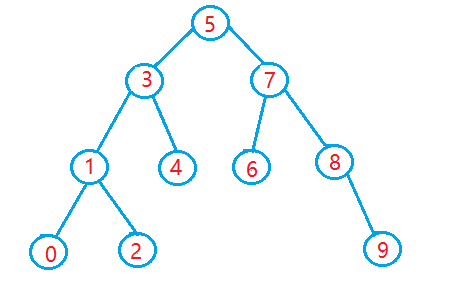二叉树是一种常见并且非常重要的数据结构,在很多项目中都能看到二叉树的身影。
它有很多变种,比如红黑树,常被用作 std::map 和 std::set 的底层实现;B 树和 B+ 树,广泛应用于数据库系统中。
本文要介绍的二叉搜索树用的也很多,比如在开源项目 go-zero 中,就被用来做路由管理。
这篇文章也算是一篇前导文章,介绍一些必备知识,下一篇再来介绍具体在 go-zero 中的应用。
二叉搜索树的特点
最重要的就是它的有序性,在二叉搜索树中,每个节点的值都大于其左子树中的所有节点的值,并且小于其右子树中的所有节点的值。
 图片
图片
这意味着通过二叉搜索树可以快速实现对数据的查找和插入。
Go 语言实现
本文主要实现了以下几种方法:
- Insert(t):插入一个节点
- Search(t):判断节点是否在树中
- InOrderTraverse():中序遍历
- PreOrderTraverse():前序遍历
- PostOrderTraverse():后序遍历
- Min():返回最小值
- Max():返回最大值
- Remove(t):删除一个节点
- String():打印一个树形结构
下面分别来介绍,首先定义一个节点:
type Node struct {
key int
value Item
left *Node //left
right *Node //right
}定义树的结构体,其中包含了锁,是线程安全的:
type ItemBinarySearchTree struct {
root *Node
lock sync.RWMutex
}插入操作:
func (bst *ItemBinarySearchTree) Insert(key int, value Item) {
bst.lock.Lock()
defer bst.lock.Unlock()
n := &Node{key, value, nil, nil}
if bst.root == nil {
bst.root = n
} else {
insertNode(bst.root, n)
}
}
// internal function to find the correct place for a node in a tree
func insertNode(node, newNode *Node) {
if newNode.key < node.key {
if node.left == nil {
node.left = newNode
} else {
insertNode(node.left, newNode)
}
} else {
if node.right == nil {
node.right = newNode
} else {
insertNode(node.right, newNode)
}
}
}在插入时,需要判断插入节点和当前节点的大小关系,保证搜索树的有序性。
中序遍历:
func (bst *ItemBinarySearchTree) InOrderTraverse(f func(Item)) {
bst.lock.RLock()
defer bst.lock.RUnlock()
inOrderTraverse(bst.root, f)
}
// internal recursive function to traverse in order
func inOrderTraverse(n *Node, f func(Item)) {
if n != nil {
inOrderTraverse(n.left, f)
f(n.value)
inOrderTraverse(n.right, f)
}
}前序遍历:
func (bst *ItemBinarySearchTree) PreOrderTraverse(f func(Item)) {
bst.lock.Lock()
defer bst.lock.Unlock()
preOrderTraverse(bst.root, f)
}
// internal recursive function to traverse pre order
func preOrderTraverse(n *Node, f func(Item)) {
if n != nil {
f(n.value)
preOrderTraverse(n.left, f)
preOrderTraverse(n.right, f)
}
}后序遍历:
func (bst *ItemBinarySearchTree) PostOrderTraverse(f func(Item)) {
bst.lock.Lock()
defer bst.lock.Unlock()
postOrderTraverse(bst.root, f)
}
// internal recursive function to traverse post order
func postOrderTraverse(n *Node, f func(Item)) {
if n != nil {
postOrderTraverse(n.left, f)
postOrderTraverse(n.right, f)
f(n.value)
}
}返回最小值:
func (bst *ItemBinarySearchTree) Min() *Item {
bst.lock.RLock()
defer bst.lock.RUnlock()
n := bst.root
if n == nil {
return nil
}
for {
if n.left == nil {
return &n.value
}
n = n.left
}
}由于树的有序性,想要得到最小值,一直向左查找就可以了。
返回最大值:
func (bst *ItemBinarySearchTree) Max() *Item {
bst.lock.RLock()
defer bst.lock.RUnlock()
n := bst.root
if n == nil {
return nil
}
for {
if n.right == nil {
return &n.value
}
n = n.right
}
}查找节点是否存在:
func (bst *ItemBinarySearchTree) Search(key int) bool {
bst.lock.RLock()
defer bst.lock.RUnlock()
return search(bst.root, key)
}
// internal recursive function to search an item in the tree
func search(n *Node, key int) bool {
if n == nil {
return false
}
if key < n.key {
return search(n.left, key)
}
if key > n.key {
return search(n.right, key)
}
return true
}删除节点:
func (bst *ItemBinarySearchTree) Remove(key int) {
bst.lock.Lock()
defer bst.lock.Unlock()
remove(bst.root, key)
}
// internal recursive function to remove an item
func remove(node *Node, key int) *Node {
if node == nil {
return nil
}
if key < node.key {
node.left = remove(node.left, key)
return node
}
if key > node.key {
node.right = remove(node.right, key)
return node
}
// key == node.key
if node.left == nil && node.right == nil {
node = nil
return nil
}
if node.left == nil {
node = node.right
return node
}
if node.right == nil {
node = node.left
return node
}
leftmostrightside := node.right
for {
//find smallest value on the right side
if leftmostrightside != nil && leftmostrightside.left != nil {
leftmostrightside = leftmostrightside.left
} else {
break
}
}
node.key, node.value = leftmostrightside.key, leftmostrightside.value
node.right = remove(node.right, node.key)
return node
}删除操作会复杂一些,分三种情况来考虑:
- 如果要删除的节点没有子节点,只需要直接将父节点中,指向要删除的节点指针置为 nil 即可
- 如果删除的节点只有一个子节点,只需要更新父节点中,指向要删除节点的指针,让它指向删除节点的子节点即可
- 如果删除的节点有两个子节点,我们需要找到这个节点右子树中的最小节点,把它替换到要删除的节点上。然后再删除这个最小节点,因为最小节点肯定没有左子节点,所以可以应用第二种情况删除这个最小节点即可
最后是一个打印树形结构的方法,在实际项目中其实并没有实际作用:
func (bst *ItemBinarySearchTree) String() {
bst.lock.Lock()
defer bst.lock.Unlock()
fmt.Println("------------------------------------------------")
stringify(bst.root, 0)
fmt.Println("------------------------------------------------")
}
// internal recursive function to print a tree
func stringify(n *Node, level int) {
if n != nil {
format := ""
for i := 0; i < level; i++ {
format += " "
}
format += "---[ "
level++
stringify(n.left, level)
fmt.Printf(format+"%d\n", n.key)
stringify(n.right, level)
}
}单元测试
下面是一段测试代码:
func fillTree(bst *ItemBinarySearchTree) {
bst.Insert(8, "8")
bst.Insert(4, "4")
bst.Insert(10, "10")
bst.Insert(2, "2")
bst.Insert(6, "6")
bst.Insert(1, "1")
bst.Insert(3, "3")
bst.Insert(5, "5")
bst.Insert(7, "7")
bst.Insert(9, "9")
}
func TestInsert(t *testing.T) {
fillTree(&bst)
bst.String()
bst.Insert(11, "11")
bst.String()
}
// isSameSlice returns true if the 2 slices are identical
func isSameSlice(a, b []string) bool {
if a == nil && b == nil {
return true
}
if a == nil || b == nil {
return false
}
if len(a) != len(b) {
return false
}
for i := range a {
if a[i] != b[i] {
return false
}
}
return true
}
func TestInOrderTraverse(t *testing.T) {
var result []string
bst.InOrderTraverse(func(i Item) {
result = append(result, fmt.Sprintf("%s", i))
})
if !isSameSlice(result, []string{"1", "2", "3", "4", "5", "6", "7", "8", "9", "10", "11"}) {
t.Errorf("Traversal order incorrect, got %v", result)
}
}
func TestPreOrderTraverse(t *testing.T) {
var result []string
bst.PreOrderTraverse(func(i Item) {
result = append(result, fmt.Sprintf("%s", i))
})
if !isSameSlice(result, []string{"8", "4", "2", "1", "3", "6", "5", "7", "10", "9", "11"}) {
t.Errorf("Traversal order incorrect, got %v instead of %v", result, []string{"8", "4", "2", "1", "3", "6", "5", "7", "10", "9", "11"})
}
}
func TestPostOrderTraverse(t *testing.T) {
var result []string
bst.PostOrderTraverse(func(i Item) {
result = append(result, fmt.Sprintf("%s", i))
})
if !isSameSlice(result, []string{"1", "3", "2", "5", "7", "6", "4", "9", "11", "10", "8"}) {
t.Errorf("Traversal order incorrect, got %v instead of %v", result, []string{"1", "3", "2", "5", "7", "6", "4", "9", "11", "10", "8"})
}
}
func TestMin(t *testing.T) {
if fmt.Sprintf("%s", *bst.Min()) != "1" {
t.Errorf("min should be 1")
}
}
func TestMax(t *testing.T) {
if fmt.Sprintf("%s", *bst.Max()) != "11" {
t.Errorf("max should be 11")
}
}
func TestSearch(t *testing.T) {
if !bst.Search(1) || !bst.Search(8) || !bst.Search(11) {
t.Errorf("search not working")
}
}
func TestRemove(t *testing.T) {
bst.Remove(1)
if fmt.Sprintf("%s", *bst.Min()) != "2" {
t.Errorf("min should be 2")
}
}上文中的全部源码都是经过测试的,可以直接运行,并且已经上传到了 GitHub,需要的同学可以自取。
源码地址:
- https://github.com/yongxinz/go-example





























